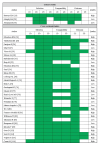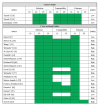Influence of Fatty Infiltration of Muscle on Falls and Fall-Related Outcomes in Middle-Aged and Older Adults: A Systematic Review
- PMID: 40385727
- PMCID: PMC12082379
- DOI: 10.7759/cureus.82345
Influence of Fatty Infiltration of Muscle on Falls and Fall-Related Outcomes in Middle-Aged and Older Adults: A Systematic Review
Abstract
Fatty infiltration of muscle is increasingly recognized as a factor contributing to fall risk in middle-aged and older adults. The goal of this study is to systematically review the literature on the influence of fatty infiltration of muscle on falls and fall-related outcomes in middle-aged and older adults. Five databases - PubMed, the Cochrane Central Register of Controlled Trials, Cumulative Index to Nursing and Allied Health Literature, Web of Science, and Igaku Chuo Zasshi - were comprehensively searched. In addition, relevant studies were identified through hand searching of the reference lists of included articles. Study quality was assessed using the Newcastle-Ottawa scale. We initially identified 1,450 articles through database searches and an additional 26 articles through hand searching. After screening, 97 observational studies were included in the final analysis. Medical imaging modalities for fatty infiltration of muscle were CT, MRI, ultrasonography, and peripheral quantitative CT. Outcomes included falls, comfortable walking speed, maximum walking speed, the timed up and go test, the short physical performance battery, muscle strength, the 6-min walk test, the five times sit-to-stand test, the 30-s chair stand test, and other balance tests. Most of the surveyed studies indicated a potential association between lower extremity major fatty infiltration of muscle and falls. Similarly, fatty infiltration of muscle was associated with poorer fall-related outcomes. However, these studies included varied participant characteristics and methods for assessing fatty infiltration of muscle and exhibited a mixed risk of bias. In conclusion, our systematic review provides important evidence on assessing fatty infiltration of the muscle for fall prevention in older adults, while underscoring the need for careful interpretation and further research, considering variations in participant characteristics, assessment methods, and potential biases.
Keywords: fall-related outcomes; falls; fatty infiltration of muscle; middle-aged; older adults.
Copyright © 2025, Shinonaga et al.
Conflict of interest statement
Conflicts of interest: In compliance with the ICMJE uniform disclosure form, all authors declare the following: Payment/services info: All authors have declared that no financial support was received from any organization for the submitted work. Financial relationships: All authors have declared that they have no financial relationships at present or within the previous three years with any organizations that might have an interest in the submitted work. Other relationships: All authors have declared that there are no other relationships or activities that could appear to have influenced the submitted work.
Figures











Similar articles
-
Interventions to Prevent Falls in Community-Dwelling Older Adults: A Systematic Review for the U.S. Preventive Services Task Force [Internet].Rockville (MD): Agency for Healthcare Research and Quality (US); 2018 Apr. Report No.: 17-05232-EF-1. Rockville (MD): Agency for Healthcare Research and Quality (US); 2018 Apr. Report No.: 17-05232-EF-1. PMID: 30234932 Free Books & Documents. Review.
-
Exercise for reducing falls in people living with and beyond cancer.Cochrane Database Syst Rev. 2018 Oct 15;10(10):CD011687. doi: 10.1002/14651858.CD011687.pub2. Cochrane Database Syst Rev. 2018. PMID: 30320433 Free PMC article. Review.
-
Prevention of falls and fall-related injuries in community-dwelling seniors: an evidence-based analysis.Ont Health Technol Assess Ser. 2008;8(2):1-78. Epub 2008 Oct 1. Ont Health Technol Assess Ser. 2008. PMID: 23074507 Free PMC article.
-
Effect of Wii Fit Exercise With Balance and Lower Limb Muscle Strength in Older Adults: A Meta-Analysis.Front Med (Lausanne). 2022 May 6;9:812570. doi: 10.3389/fmed.2022.812570. eCollection 2022. Front Med (Lausanne). 2022. PMID: 35602499 Free PMC article.
-
A best practice fall prevention exercise program to improve balance, strength / power, and psychosocial health in older adults: study protocol for a randomized controlled trial.BMC Geriatr. 2013 Oct 9;13:105. doi: 10.1186/1471-2318-13-105. BMC Geriatr. 2013. PMID: 24106864 Free PMC article. Clinical Trial.
References
-
- Factors predicting fractures during falling impacts among home-dwelling older adults. Luukinen H, Koski K, Laippala P, Kivelä SL. J Am Geriatr Soc. 1997;45:1302–1309. - PubMed
-
- Falls, injuries due to falls, and the risk of admission to a nursing home. Tinetti ME, Williams CS. N Engl J Med. 1997;337:1279–1284. - PubMed
-
- Anxiety after a fall in elderly subjects and subsequent risk of developing post traumatic stress disorder at two months. A pilot study. Bloch F, Blandin M, Ranerison R, Claessens YE, Rigaud AS, Kemoun G. J Nutr Health Aging. 2014;18:303–306. - PubMed
Publication types
LinkOut - more resources
Full Text Sources
